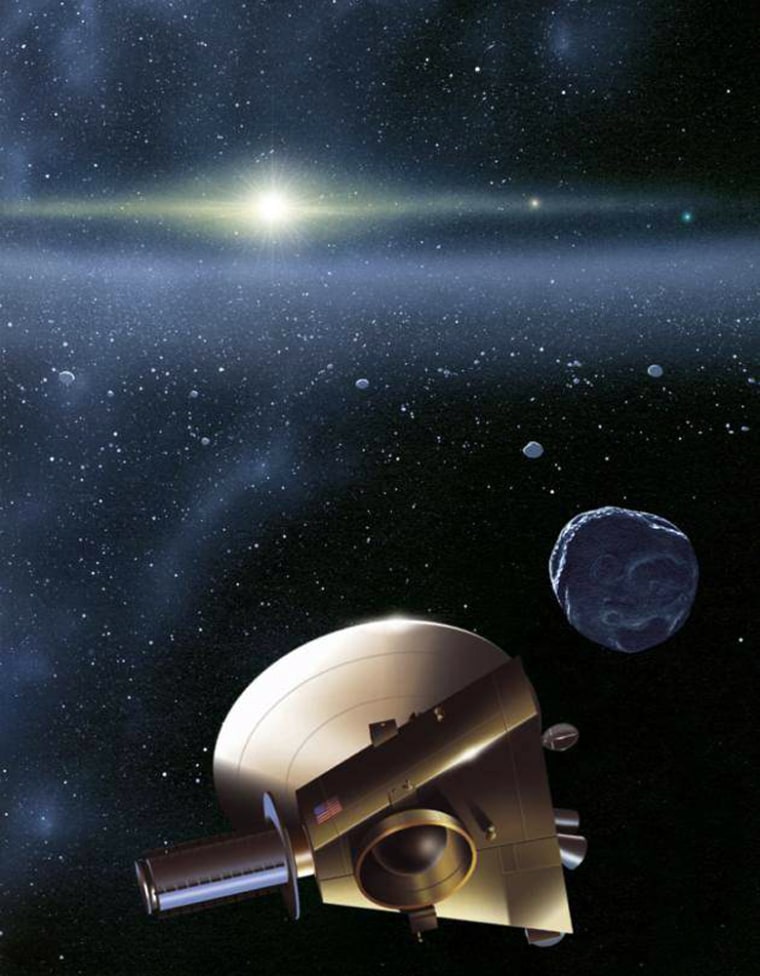NASA’s New Horizons probe bound for Pluto is headed for a Jupiter flyby, its camera eyes wide open, in preparation for its swing out towards the fringe of the solar system.
New Horizons began taking black-and-white images of Jupiter and scanning the planet’s icy moon Callisto in the infrared this week as it prepares for a close encounter with the gas giant next month.
“They’re certainly all we could have hoped for,” New Horizons principal investigator Alan Stern, of the Southwest Research Institute in Boulder, Colorado, said Thursday of the new Jupiter images. “We’re still 100 million kilometers out. We’re going to get 50 times closer, but they are very nice.”
The images are expected to be released next week. NASA officials also plan to hold a press briefing on the New Horizons mission on Jan. 18.
New Horizons has been billed as NASA’s fastest mission to date. The probe is set to make its closest pass by Jupiter on Feb. 28, just over one year after its Jan. 19, 2006 launch, and swing within 1.4 million miles (2.3 million kilometers) of the gas giant.
NASA’s Galileo mission to Jupiter took about six years before it reached the planet in 1995. But that spacecraft went into orbit around the gas giant and spent eight years studying Jupiter and its many moons. While New Horizons will make 700 individual observations of Jupiter over six months, the probe is hunting a far more distant quarry.
Slideshow 12 photos
Month in Space: January 2014
New Horizon’s Jupiter flyby, and subsequent gravity boost, will shave a full three years off the probe’s journey to Pluto, though Stern attributes that to the January 2006 launch that put the spacecraft on target for a 2015 rendezvous.
“We are really healthy,” Stern said of the spacecraft. “We don’t have a single device that’s broken on the spacecraft.”
About the size of grand piano, New Horizons carries seven instruments to study Jupiter, Pluto and its moons. The probe may also survey the distant icy Kuiper Belt Objects if its mission is ultimately extended. New Horizons is speeding through the solar system at about 44,537miles (71,675kilometers) per hour and has already shot past Mars, the Asteroid Belt and snapped images of Jupiter and a space rock formerly known as Asteroid 2002 JF56.
“It’s called APL,” said Stern, whose along with his team named the asteroid after the Applied Physics Laboratory at Maryland’s Johns Hopkins University, which is overseeing the New Horizons mission for NASA. “The 2002 JF56 provisional designation is now history.”
The probe is expected to make its closest pass by the distant planet and its trio of moons on July 14, 2015. But first, the spacecraft must swing past Jupiter.
Stern said mission controllers have been working round-the-clock on New Horizon’s Jupiter flyby since October, and are gearing up for a busy rendezvous in late February.
“We are now in the late stages of planning the closest approach,” Stern told SPACE.com, adding that the flight plan will be uploaded to New Horizons in mid-February. “The spacecraft is going to get busy.”

It will also be a busy time for Stern too, who is the not only the principle investigator for New Horizon’s Alice ultraviolet spectrometer instrument, but also the lead for a similar tool aboard the European Space Agency’s Rosetta probe bound for a 2014 visit to the Comet 67P/Churyumov-Gerasimenko.
“The same week that New Horizons is at Jupiter, Rosetta is doing its Mars flyby,” said Stern, adding that a busy year lies ahead.
Stern said the New Horizons team ended 2006 with a celebration of sorts by honoring Venetia Burney, a nearly 88-year-old Englishwoman who – as an 11-year-old girl – gave Pluto its name in 1930.
New Horizon team members named the probe’s Student Dust Counter instrument after Burney, with Stern and mission co-investigators presenting her with a plaque on Dec. 19.
“It was fun to meet Venetia in person and to hear about how she came to name Pluto so long ago,” Stern wrote in a mission status update last week. “She's healthy and witty and wishing for a chance to be at our Pluto encounter in 2015; that seems like something we should make happen.”
